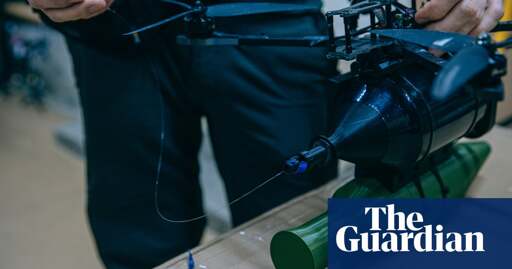At a secret workshop in Ukraine’s north-east, where about 20 people assemble hundreds of FPV (first person view) drones, there is a new design. Under the frame of the familiar quadcopter is a cylinder, the size of a forearm. Coiled up inside is fibre optic cable, 10km (6 miles) or even 20km long, to create a wired kamikaze drone.
Capt Yuriy Fedorenko, the commander of a specialist drone unit, the Achilles regiment, says fibre optic drones were an experimental response to battlefield jamming and rapidly took off late last year. With no radio connection, they cannot be jammed, are difficult to detect and able to fly in ways conventional FPV drones cannot.
“If pilots are experienced, they can fly these drones very low and between the trees in a forest or tree line. If you are flying with a regular drone, the trees block the signal unless you have a re-transmitter close,” he observes. Where tree lined supply roads were thought safer, fibre optic drones have been able to get through.



Primary issues I can see with retrieval are tangling/kinking and re-spooling/splicing. The fibers are insanely thin and the drones are flying in between trees, not exactly a smooth path for retrieval.
I saw a picture a few weeks ago of a field in Ukraine, taken from amongst an adjacent patch of trees, and it just looks like spiderwebs. Dozens and dozens of fine spider web strands, each one delivering a drone into the meat grinder. Terrible, beautiful, and such a fucking waste.
What are all those glass fibers going to do to an area after the war ends? That stuff won’t decompose.
Fibre glass is essentially silica fibres with a trace amount of metal to make the fibre glass act the way it does. Guess what sand is also made of, silica with trace amounts of impurities. So when they break down it’ll just be sand in the end. Not ‘decomposable’ but quite friendly to the environment still.
You’ve obviously never embedded a piece of fibre optic cable in your skin. It’s very sharp and will break off inside. It’s not exactly life threatening, but it hurts like a bitch and can be really hard to find and remove.
Yes, that is obvious. I’m not worried about chemical contamination. Physical contamination and injury is the problem. I’m much more worried about civilians interacting with an environment saturated with these things. A kid is riding a dirt bike through the woods one day and gets garroted on an invisible glass wire dangling between two trees.
In an interesting tangent, that’s actually a thing in brazil. If I remember, there are laws in place that make it illegal to operate a motorcycle without a wire cutter on it.
To be fair it’s much better than unexploded bombs and mines.
I doubt the wire would be strong enough to not snap in that case.
Same can be said for the landmines that the Russian are hiding in Ukrainian soil
I live in an area where fires are frequent and aerial cables plentiful.
Once in a while, a crew comes around and picks up all the broken cable. But considering these are mostly glass, non insulated cables, I’d risk it just becomes another inert part of the soil.
Hopefully, there will be a retrieval plan, after all the madness ends.
It’s also not going to explode so probably less of an issue on the whole than all the UXO there…